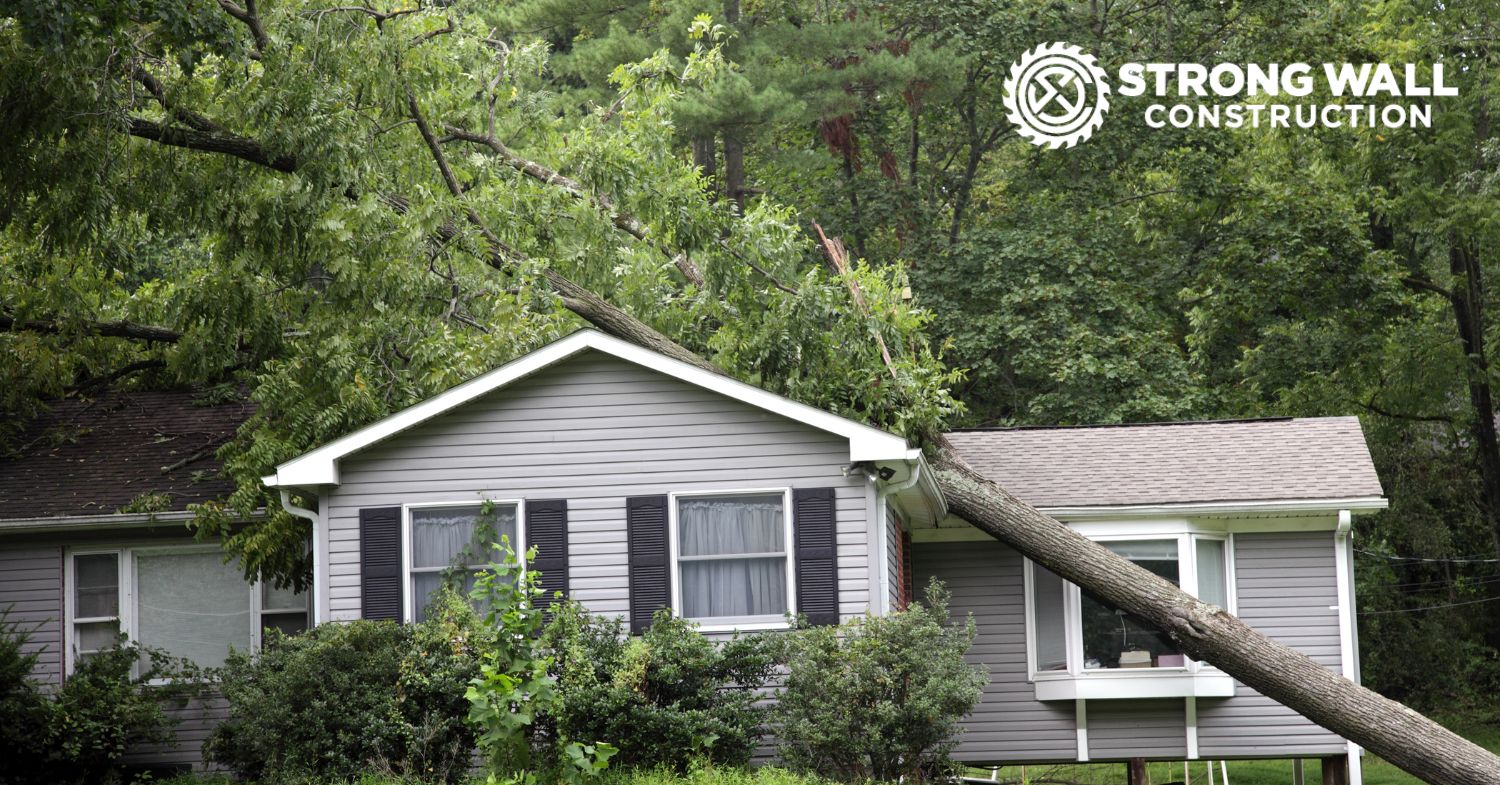As spring ushers in its mild breezes and budding blooms, it also brings with it…

Battling the Elements: How to Storm Proof Homes
Weather-related damage to homes is becoming more prevalent. Between 2017 and 2021, weather-related property damage skyrocketed to a staggering $121.4 billion. This number will likely rise as extreme weather becomes more frequent nationwide. This is why having storm proof homes will become increasingly more important as time goes on.
We understand how storms affect homeowners and their property at Strong Wall Construction and know that in the face of severe weather, you want to keep your home and loved ones safe. In this guide, we’ll give you steps to storm proof your home. We’re here to help you strengthen your house.
1. Assess Your Home’s Vulnerabilities
Storm-proofing your home begins with assessing its vulnerabilities. Understanding the specific threats your home might face is crucial. Start by researching the signs of bad weather typical in your region, whether it’s heavy rain, high winds, or snowstorms.
Once you know what to expect, inspect your home’s construction and materials for weak points. Look for cracks, leaks, or damaged areas that could compromise your storm-proof house. This initial assessment lays the foundation for effective storm preparedness.
2. Conduct Exterior Storm Preparations
By taking these proactive steps to fortify the exterior of your home, you’ll be well on your way to achieving a storm-proof house that can better withstand the forces of nature.
Reinforce Roofs and Shingles
Start by ensuring your roof is up to the task. Installing hurricane straps can significantly enhance its strength, preventing it from being torn off during high winds. Additionally, consider using impact-resistant shingles that can withstand hail and debris, reducing the risk of leaks and damage.
Reinforce Doors and Windows
Don’t underestimate the vulnerability of your home’s entry points. If necessary, install storm shutters. These protective coverings can safeguard your windows and doors during storms.
Also, reinforce these areas, making them more secure and resistant to strong winds and flooding. These storm safety tips will help you.
Maintain the Landscape
A well-maintained landscape can go a long way in protecting your home. Regularly trimming trees and branches near your house reduces the risk of falling limbs and damage to your roof or windows during a storm.
Additionally, securing outdoor objects like patio furniture, garden tools, and decorations prevents them from becoming projectiles during high winds.
3. Waterproofing and Drainage
By addressing these aspects of storm-proofing your home, you’ll significantly reduce the risk of water damage and flooding, ensuring your home remains a safe and secure haven during severe weather events.
Inspecting and Repairing the Roof
Begin by thoroughly checking your roof for any signs of wear and tear. Look for loose or damaged shingles, and ensure all seams and flashings are secure. If you find any issues, address them promptly to prevent leaks and further damage during storms.
Clearing and Cleaning Gutters and Downspouts
Proper gutter maintenance prevents water from accumulating on your roof and around your home’s foundation. Keeping gutters free from debris ensures that rainwater is directed away from your home, reducing the risk of flooding and water damage.
Installing a Sump Pump or Flood Barrier
Consider installing a sump pump for additional protection against flooding. This device helps pump out excess water, keeping your home dry during heavy rains. You can also explore installing a flood barrier to prevent water from entering your home through vulnerable entry points.
Elevating Utilities and Electrical Systems
To safeguard your electrical systems and utilities from water damage, elevate them above potential flood levels. This step is crucial if you live in a flood-prone area. Elevating these critical components can prevent costly repairs and electrical hazards during storms.
4. Creating an Emergency Kit
The following items are essential for your storm preparedness kit:
- Non-perishable Food: Stock up on canned goods, dried fruits, nuts, and energy bars to sustain you for at least three days.
- Water: Store one gallon of water per person daily for drinking and sanitation.
- First Aid Supplies: Assemble a basic first aid kit that includes bandages, antiseptic wipes, medications, and any prescription drugs you need.
- Flashlights and Batteries: Ensure you have reliable light sources in case of power outages.
- Battery-Powered or Hand-Crank Radio: Stay informed with weather updates and emergency broadcasts.
- Blankets or Sleeping Bags: Stay warm during power outages or if you need to evacuate.
- Multi-Tool or Swiss Army Knife: These can be invaluable for various tasks during an emergency.
- Personal Hygiene Items: Include soap, hand sanitizer, toothbrush, and toilet paper.
- Important Documents: Make copies of essential documents like identification, insurance policies, and medical records.
- Cash: Have cash on hand in case ATMs and credit card machines are unavailable.
If you or a family member rely on prescription medications, ensure you have a supply that lasts beyond the expected duration of the storm. Additionally, if you have infants or pets, include formula, diapers, and pet food in your kit.
Place your emergency kit in a waterproof container or bag and store it in an easily accessible location that all household members know.
Regularly check and refresh the items in your kit to ensure they remain in good condition. Update it seasonally, considering changing weather conditions and family needs.
Lastly, create an emergency plan with your family in addition to your kit. Establish a meeting point, communication strategy, and evacuation routes.
5. Backup Power and Utilities
Installing a Generator or Backup Power Source
Consider installing a generator that suits your needs to power essential appliances during outages, especially if you live somewhere with frequent outages. Remember, professional installation and maintenance are necessary for safe and efficient operation.
You’ll need to maintain an adequate fuel supply for generators and alternative heating sources. You can also explore options like solar panels or wind turbines for sustainable power.
Protecting Against Power Surges
Use surge protectors to safeguard electronic devices and appliances from power surges during storms. Consider whole-house surge protectors for comprehensive electrical system protection.
Shutting Off Utilities During a Storm
Learn how to safely shut off your gas, water, and electricity during emergencies. Keep the necessary tools, like wrenches or pliers, in an easily accessible location.
After the Storm
After the storm has passed, it’s crucial to take immediate action to ensure your storm-proof home remains safe and secure. Conduct a thorough safety check of your home and its surroundings, looking for hazards such as downed power lines, structural damage, or gas leaks. Prioritize the safety of everyone in your household, ensuring they are secure and accounted for.
In case of a gas leak, evacuate the premises immediately and contact your gas provider and emergency services. Once everyone is safe, assess the damage’s extent by inspecting your home both inside and outside, documenting all visible damage for insurance purposes. These tips will get you off to a good start, and for more detailed information, we have another blog on storm cleanup and recovery.
Storm Restoration with Strong Wall Construction
Navigating the aftermath of a storm can be a challenging journey filled with emotions, difficult decisions, and a sense of uncertainty. We hope that using these tips to storm proof homes will make the aftermath a little easier to deal with. At Strong Wall Construction, we are more than just contractors; we are your dedicated partners in rebuilding your life and home.
We firmly believe that no homeowner should face the restoration process alone. We specialize in helping homeowners navigate the intricate path of recovery after a storm. Our mission is to stand with you through every phase, easing the burden and providing expert guidance from the initial assessment to the day you step back into your newly restored home.
With experience spanning over 75 years in insurance, restoration, and remodeling, our commitment to customer care, quality workmanship, and transparent pricing is unwavering. We proudly serve the greater Baltimore area and are just a phone call away. Talk to our experts today, and let us assist you in rebuilding and regaining the security and comfort you deserve after the storm.



